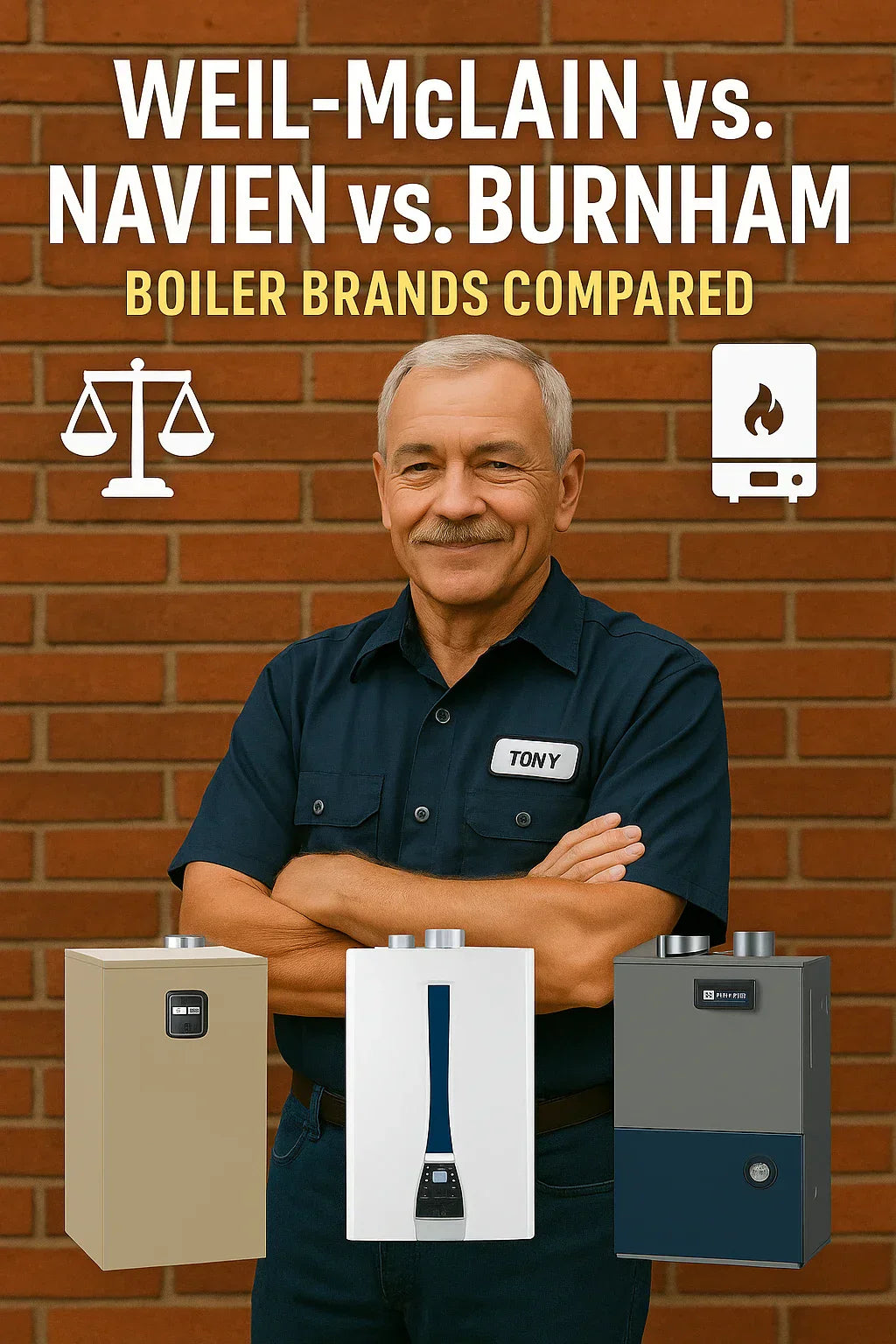🏡 Why Brand Comparison Matters Before Your Boiler Purchase
Choosing between Weil-McLain, Navien, and Burnham can significantly affect your home's comfort, energy bills, and maintenance needs for decades. Tony often sees homeowners overwhelmed by options, but brand clarity ensures you get the best value for your climate, fuel type, and installation needs.
This guide will break down:
-
Efficiency and technology differences.
-
Reliability and typical lifespans.
-
Maintenance, parts, and service availability.
-
Noise and size differences.
-
Cost comparisons.
-
Which brand suits your home best.
🔋 Efficiency and Technology Differences
Weil-McLain:
-
Offers high-efficiency condensing boilers (up to 95% AFUE) and standard cast iron models.
-
Features modulating burners on models like the Evergreen and Ultra Series.
-
Extensive product lineup for gas and oil.
Navien:
-
Specializes in high-efficiency, wall-hung condensing boilers with up to 95-98% AFUE.
-
Integrated combi units for space and water heating.
-
Advanced controls and WiFi-enabled options.
Burnham:
-
Offers a mix of high-efficiency condensing boilers (Alpine, K2) and robust cast iron models (Series 2).
-
Focus on simplicity and proven design.
For efficiency comparisons, see ENERGY STAR Boiler Listings.
🛠️ Reliability and Lifespan
Weil-McLain:
-
Known for durable cast iron models lasting 20-30 years.
-
Condensing models have typical lifespans of 15-20 years with proper maintenance.
Navien:
-
Designed for 15-20 years of service with high-efficiency parts.
-
Lightweight components require consistent maintenance to maximize lifespan.
Burnham:
-
Cast iron boilers often last 25-30 years.
-
Condensing models last 15-20 years with annual maintenance.
For reliability insights, see Consumer Reports Guide to Boilers.
🔧 Maintenance and Parts Availability
Weil-McLain:
-
Widely available parts in North America.
-
Most HVAC technicians are familiar with servicing them.
-
Requires annual cleaning and inspection, especially for oil units.
Navien:
-
Parts are available but may require ordering through Navien-specific channels.
-
Annual maintenance is critical to maintain warranty.
-
Technicians require familiarity with Navien’s advanced controls.
Burnham:
-
Readily available parts.
-
Simple design allows easy maintenance by most HVAC professionals.
Learn about maintenance expectations at Energy.gov’s Boiler Maintenance Guide.
🔊 Noise and Size Considerations
Weil-McLain:
-
Cast iron models are larger, floor-standing units.
-
Condensing units are quieter, with some wall-mount options.
Navien:
-
Compact, wall-hung designs save space.
-
Extremely quiet operation.
Burnham:
-
Larger footprint for cast iron models.
-
Condensing models are quieter and more compact.
💰 Cost Comparison
Weil-McLain:
-
Entry-Level: $3,000 - $4,500
-
Mid-Tier: $4,500 - $7,000
-
High-Efficiency Condensing: $5,000 - $8,000
Navien:
-
Combi and Boiler Units: $3,500 - $6,500
-
Installation may require additional venting modifications.
Burnham:
-
Cast Iron: $3,000 - $5,000
-
Condensing: $4,500 - $7,500
For realistic boiler pricing, see Boiler Cost Guide.
🗺️ Climate and Application Suitability
✅ Cold Climates (Zones 5-7):
-
Weil-McLain cast iron or high-efficiency models handle large homes and extreme temperatures.
-
Burnham cast iron models excel in older homes.
-
Navien units can work, but sizing is critical due to peak demand.
✅ Moderate Climates (Zones 3-4):
-
Navien combi boilers offer heating and domestic hot water with high efficiency.
-
Weil-McLain and Burnham condensing models work well.
✅ Space-Conscious Homes:
-
Navien and select Weil-McLain wall-hung models save space in utility closets.
Learn more about climate considerations at Energy Saver’s Heating Guide.
🛠️ Tony’s Perspective: Brand Pros and Cons
Weil-McLain Pros: ✅ Proven reliability and availability of parts. ✅ Broad model selection for all fuel types. ✅ Cast iron models excellent for extreme climates. ✅ Installer familiarity reduces service complications.
Weil-McLain Cons: ❌ Larger footprint for many models. ❌ Condensing models require annual maintenance.
Navien Pros: ✅ Compact, quiet, high-efficiency. ✅ Combi units simplify space and water heating. ✅ Advanced controls for fine-tuning efficiency.
Navien Cons: ❌ Sensitive to water quality and maintenance lapses. ❌ Limited installer familiarity in some regions.
Burnham Pros: ✅ Simple, proven cast iron reliability. ✅ Good efficiency options in condensing models. ✅ Easy to service with available parts.
Burnham Cons: ❌ Larger size in non-condensing models. ❌ Fewer advanced control options.
🚀 Which Brand Should You Choose?
✅ Choose Weil-McLain if:
-
You need a proven, reliable system with broad installer support.
-
You live in a cold climate and prioritize durability.
-
You want options between oil, gas, and different efficiency levels.
✅ Choose Navien if:
-
You need a compact, high-efficiency, wall-hung system.
-
You want a combi unit for space and water heating.
-
You have quality water and will commit to consistent maintenance.
✅ Choose Burnham if:
-
You need a straightforward, durable system for a larger home.
-
You prefer simplicity with easy servicing.
-
You want a balance between efficiency and proven longevity.
📋 Final Steps Before You Buy
✅ Confirm your heat loss calculation to size your boiler correctly.
✅ Check fuel availability and pricing in your region.
✅ Evaluate space constraints and venting compatibility.
✅ Investigate rebates for high-efficiency boilers at the DSIRE Database.
🔗 Ready to Choose Your Boiler?
Use this brand comparison to match your comfort, efficiency, and budget needs. For expert advice and pricing, explore the Weil-McLain Boilers Collection to begin your upgrade today.







